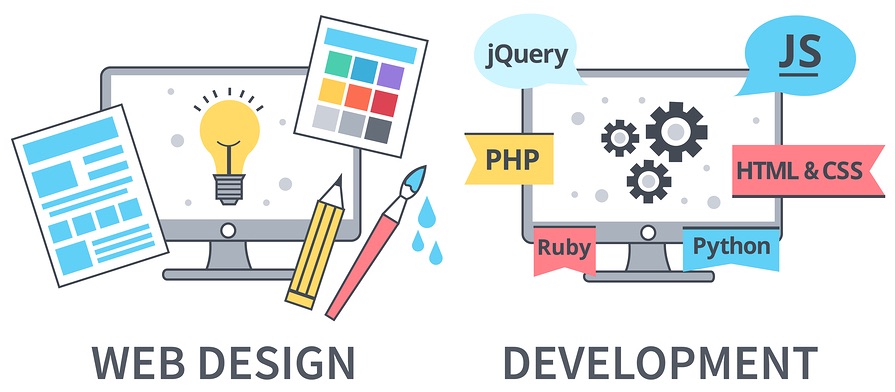The connection between branding and website design for business growth
Everything About Internet Design: Recognizing Its Relevance for Your Online Existence
Web style works as a fundamental element of establishing an online existence. It influences individual experiences and forms understandings of brand names. Reliable website design includes numerous components that enhance use and involvement. As the digital landscape evolves, understanding the relevance of these layout principles ends up being important (website design). What are the essential elements that make a site not just practical, but compelling? Exploring this could reveal important understandings for anyone aiming to succeed online
The Role of Web Layout in Individual Experience
Website design exceptionally affects individual experience by shaping exactly how visitors interact with a website. Aspects such as design, color design, and typography develop the impression, leading customers via the material. Efficient website design prioritizes instinctive navigating, making sure that visitors can easily discover details without stress. Responsive layout improves access throughout different tools, catering to a more comprehensive audience. The speed of a site likewise plays a vital role; slower-loading web pages can result in higher bounce rates and reduced customer satisfaction. Aesthetic power structure, achieved through spacing and size modifications, guides individuals' interest to key functions or calls to activity. Uniformity in style aspects cultivates experience and trust fund, urging users to involve even more deeply. Eventually, a well-designed website not just draws in site visitors yet also preserves them, influencing their general assumption of the brand or service it stands for. By doing this, internet style is a basic part of a successful online existence.
Crucial Element of Efficient Website Design
Effective internet style depends upon a number of crucial elements that improve user interaction and complete satisfaction. Aesthetic hierarchy principles guide individuals via material, making sure that crucial info stands out - web design. Mobile responsiveness is necessary in a digital landscape where customers gain access to web sites throughout numerous gadgets.
Aesthetic Hierarchy Principles
Although many elements add to an effective site, the principles of visual power structure attract attention as foundational to guiding customer experience. Aesthetic hierarchy describes the arrangement of layout aspects to interact importance and straight users' focus effectively. Secret aspects include dimension, color, comparison, and spacing, which assist prioritize information and produce a flow that is instinctive for individuals. Larger components usually draw the eye initially, while contrasting colors can highlight contact us to action. Thoughtful spacing can likewise boost readability and comprehension. By using these concepts, designers can craft a seamless experience that not just involves users however likewise helps with navigation and enhances overall usability. Inevitably, a well-executed visual pecking order boosts the web site's effectiveness in conveying its message.
Mobile Responsiveness Essentials
Mobile responsiveness is an important element of modern website design, making certain that sites work flawlessly throughout numerous devices and display dimensions. This adaptability enhances user experience, as site visitors can access content effortlessly whether they utilize a desktop computer, smart device, or tablet . Crucial element of mobile responsiveness consist of fluid grids, adaptable photos, and media questions, which permit designs to change dynamically. Prioritizing touch-friendly navigating and clear typography even more enhances use on smaller sized screens. Furthermore, enhancing loading speeds is vital, as mobile individuals typically expect fast accessibility to info. By implementing these basics, web designers create websites that involve users, decrease bounce rates, and inevitably add to enhanced conversions and consumer contentment. Mobile responsiveness is thus important for keeping a competitive online visibility.
The Effect of Website Design on Brand Assumption
Website design substantially influences brand name perception, beginning with the vital impression a site makes on site visitors. Regular visual components enhance trust fund and acknowledgment, strengthening the brand name's identity. Furthermore, a favorable customer experience can shape just how customers see and involve with the brand name overall.
Impressions Matter
When visitors run into a site, their initial reaction can considerably influence their assumption of the brand. A well-designed web site can stimulate sensations of professionalism and trust, trust fund, and dependability, while an inadequately created one might cause suspicion and doubt. Customers usually develop judgments within seconds, making the first impression essential. Components such as design, color schemes, and typography play substantial duties in forming these first ideas. A clean and contemporary layout can convey development, whereas out-of-date visuals may recommend overlook. In addition, an intuitive navigation system enhances individual experience, enhancing positive perceptions. Efficient internet layout not only records focus but additionally establishes a strong structure for brand name identity, affecting ongoing connections with site visitors and possible clients.
Visual Consistency Develops Depend On

Customer Experience Affects Assumption
A natural visual identity prepares for a favorable customer experience, which substantially affects brand name assumption. Efficient website design assurances that users can browse a web site without effort, causing higher contentment and involvement. They are extra most likely to link the brand with professionalism and integrity when individuals experience a visually pleasing and functional site. Alternatively, poor layout can result in aggravation, creating customers to form unfavorable perceptions. Components such as shade schemes, typography, and layout play a necessary duty fit psychological feedbacks. Ultimately, a well-designed website not only enhances usability but likewise strengthens the brand name's values and message, developing a long-term effect on customer understanding and commitment. Consistency in style even more solidifies this connection, fostering count on and familiarity.
Search Engine Optimization and Internet Layout
Reliable website design is important for enhancing search engine optimization (SEARCH ENGINE OPTIMIZATION), as it straight influences exactly how internet search engine creep and index a website. A well-structured site, including instinctive navigating and clear power structures, permits search engines to conveniently recognize the material and its importance. In addition, making use of maximized meta tags, headings, and alt message for images even more aids in enhancing exposure in internet search engine results.
Additionally, page lots speed, an essential element of internet design, considerably influences SEO positions. Web sites that fill slowly may discourage customers, leading to greater bounce prices, which internet search engine take an adverse signal.
Incorporating search engine optimization best techniques right into internet layout not just boosts internet search engine positions however also assures that site visitors have a favorable experience. Eventually, an alternative technique to website design and SEO can lead to boosted web traffic, far better customer interaction, and improved conversion rates, making it crucial for online success.
Receptive Design: Fulfilling User Needs Across Instruments
As individuals progressively accessibility sites from a variety of devices, responsive style has become a crucial solution for fulfilling their requirements. This approach assures that internet pages adapt perfectly to different screen alignments, sizes, and resolutions, giving an excellent watching experience. By employing fluid grids, flexible photos, and media inquiries, responsive style allows web content to range and rearrange, boosting use throughout desktops, smart devices, and tablets.
Receptive design boosts site efficiency, as it often lowers filling times via optimized images and streamlined code. This efficiency not only improves individual satisfaction however likewise adds to far better online search engine rankings, as online search engine prefer mobile-friendly websites. As the digital landscape remains to develop, businesses that focus on receptive style are better outfitted to involve their audiences effectively, guaranteeing that individuals can browse and interact with material no matter the device they make use of. Responsive design is necessary for preserving a solid on the internet visibility.
The Relevance of Ease Of Access in Internet Style
Web style not only needs responsiveness to different devices however also demands a dedication to access for all individuals. Accessibility in internet style guarantees that individuals with disabilities can navigate, understand, and connect with on the internet web content effectively. This incorporates various components, including text readability, alternate message for pictures, and keyboard navigation alternatives. By prioritizing ease of access, helpful site internet developers create inclusive experiences that satisfy a diverse target market, thereby expanding their reach and enhancing individual complete satisfaction.
Easily accessible websites can enhance search engine optimization and decrease potential lawful risks associated with non-compliance to ease of access requirements. Companies that accept comprehensive layout not just fulfill ethical responsibilities however additionally demonstrate social obligation, promoting a favorable brand name photo. Ultimately, the significance of access in web style lies in its capability to produce equitable online atmospheres, equipping all customers, no matter of their capacities, to engage fully with digital material and solutions.
Fads in Website Design: Remaining Present in a Digital World
Staying abreast of trends in internet layout is vital for designers aiming to provide contemporary and engaging user experiences. As technology develops, so do individual assumptions, making it critical for designers to incorporate modern aspects into their job. Present fads include minimalism, which prioritizes tidy lines and visite site adequate white area, enhancing use and visual allure. Furthermore, the rise of dark setting choices satisfies customer comfort while browsing.
Receptive design remains important, guaranteeing internet sites work perfectly throughout different gadgets. The assimilation of micro-interactions adds a layer of involvement, permitting customers to really feel a connection with the website. Using strong typography and vivid shade palettes can also assist capture interest in a jampacked electronic landscape. By accepting these patterns, internet designers can develop aesthetically enticing, practical, and straightforward web sites, ultimately reinforcing their clients' on-line presence and fostering positive individual interactions.
Regularly Asked Questions
Exactly How Much Does Professional Internet Style Commonly Expense?
Professional website design normally costs in between $2,500 and $10,000, relying on complexity and attributes. Custom designs may raise costs additionally, while easier layouts can decrease costs, making prices extremely variable based upon customer needs.

Can I Design My Internet Site Without Coding Understanding?
Yes, a person can create a website without coding expertise. Numerous user-friendly web site builders and content monitoring systems supply themes and drag-and-drop features, allowing customers to produce visually appealing sites easily and effectively.
What Are Usual Blunders to Prevent in Web Style?
Usual blunders in internet style consist of messy formats, inadequate navigation, lack of mobile optimization, neglecting individual experience, sluggish filling times, utilizing also many typefaces or shades, and overlooking access. These errors can deter site visitors and lessen interaction.

How Usually Should I Update My Website's Style?
A site's layout ought to be updated every 2 to 3 years, or quicker if substantial patterns arise. Routine updates assure relevance, enhance customer experience, and preserve compatibility with brand-new modern technologies and tools, promoting recurring engagement.
What Tools Can Assist Me Produce My Own Website?
Countless tools exist for producing sites, consisting of WordPress, Wix, and Squarespace (branding). These platforms provide user-friendly user interfaces, adjustable templates, and different attributes that encourage individuals to develop websites customized to their details requirements and preferences
Internet layout exceptionally influences customer experience by forming just how visitors interact with a site. Reliable internet layout pivots on several vital components that improve individual involvement and satisfaction. Efficient internet layout warranties that customers can navigate a site without effort, leading to greater satisfaction and engagement. Staying abreast of trends in web layout is crucial for makers intending to supply appealing and modern customer experiences. Usual errors in internet design include cluttered designs, bad navigating, absence of mobile optimization, overlooking individual experience, slow loading times, using as well lots of typefaces or shades, and overlooking ease of access.